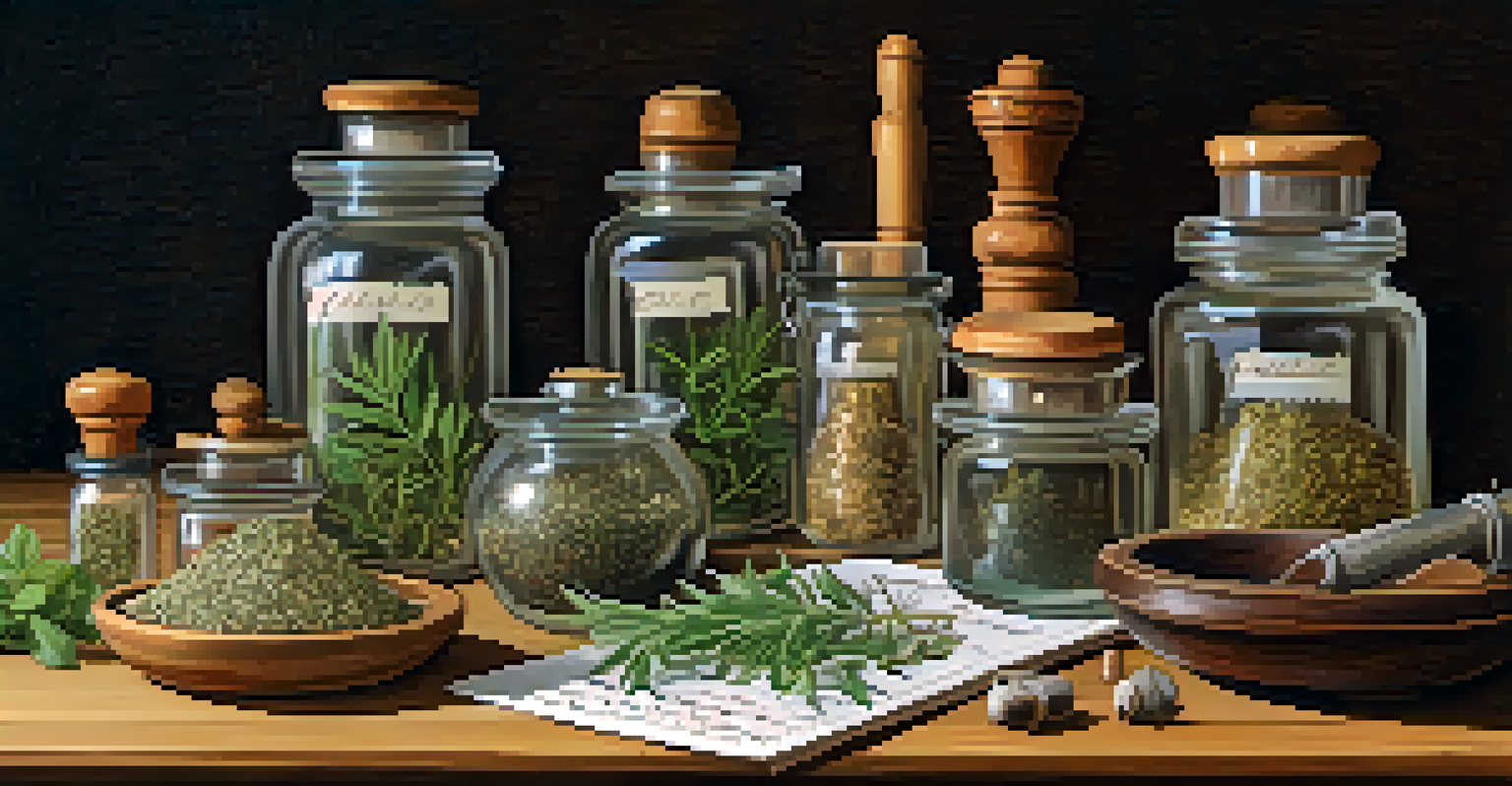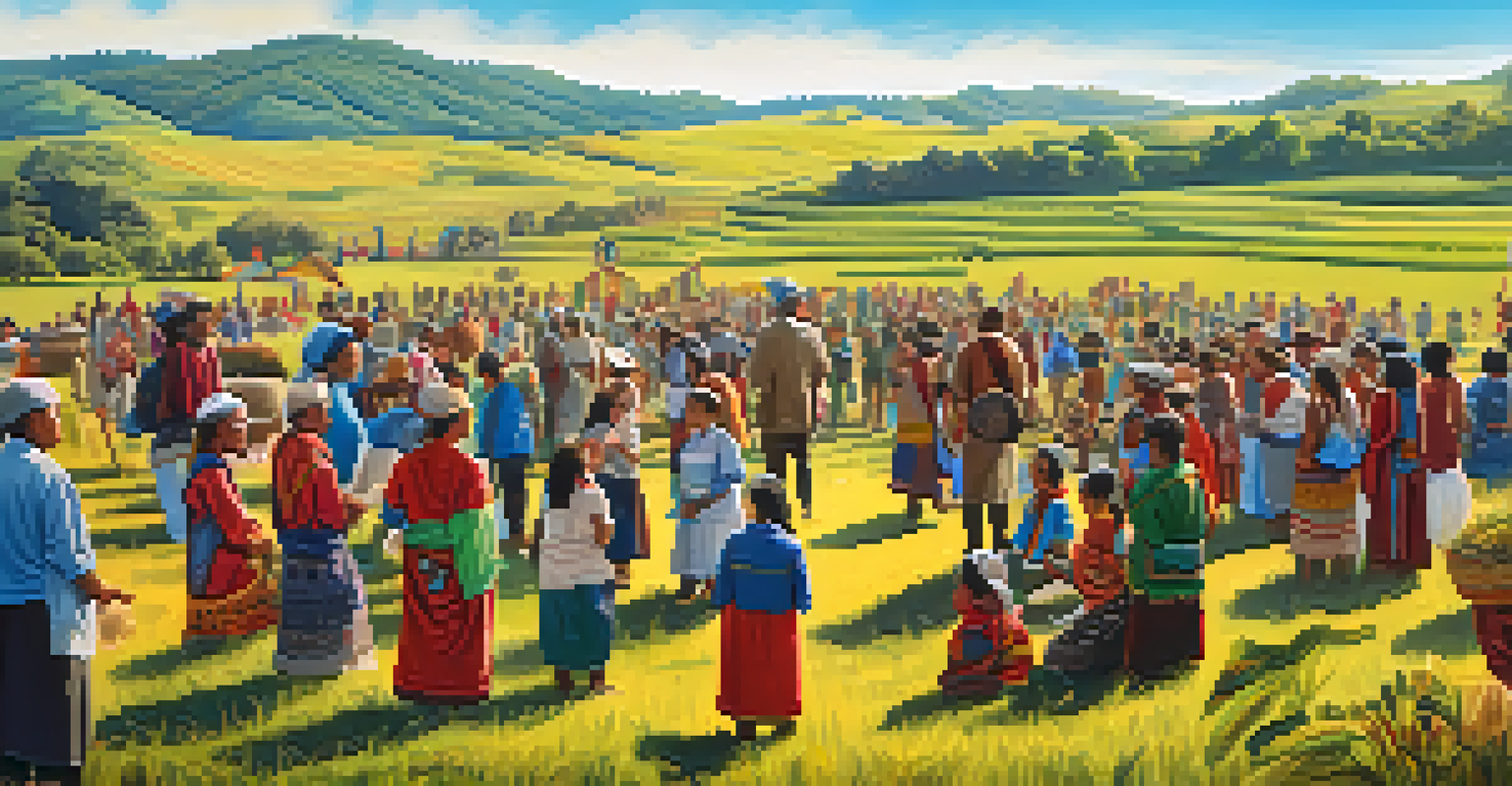Ethnobotany and Biodiversity: Preserving Plant Knowledge

Understanding Ethnobotany: The Study of Plants and People
Ethnobotany is the study that bridges the gap between plants and cultures. It examines how different societies use plants for food, medicine, and rituals, highlighting the intricate relationship between humans and the natural world. This field of study not only enriches our understanding of traditional ecological knowledge but also emphasizes the importance of preserving these practices.
Plants are the foundation of all life on Earth, and the knowledge of how to use them wisely is our greatest heritage.
For example, indigenous communities worldwide have developed extensive knowledge about local flora, often relying on plants for their survival. This knowledge includes everything from identifying medicinal herbs to understanding seasonal changes in plant availability. By documenting these practices, ethnobotanists can help ensure that such wisdom is not lost to future generations.
Ultimately, ethnobotany serves as a reminder that plants are not just resources; they are integral to the cultural identity and survival of many communities. As we explore this field, we uncover stories and practices that have shaped human history and highlight the need for their preservation.
The Role of Biodiversity in Ethnobotanical Practices
Biodiversity is the variety of life found on Earth, and it plays a crucial role in the practices of ethnobotany. A rich diversity of plants ensures that communities have access to a wide range of resources, from food and medicine to materials for shelter. This diversity not only supports cultural practices but also enhances ecological resilience.

When biodiversity diminishes, the knowledge associated with those plants often fades as well. Many traditional practices are tied to specific plants that may not be widely cultivated or recognized outside their native regions. For instance, the loss of a particular medicinal plant can disrupt a community’s healthcare practices, leading to a decline in both physical and cultural health.
Ethnobotany connects plants and culture
This field studies how societies use plants for food, medicine, and rituals, showcasing the vital relationship between humans and nature.
Preserving biodiversity is therefore essential to safeguarding the knowledge that communities have developed over centuries. By protecting diverse ecosystems, we maintain the living libraries of plant knowledge that are crucial for both current and future generations.
Threats to Ethnobotanical Knowledge and Biodiversity
Despite its importance, ethnobotanical knowledge and biodiversity face numerous threats. Urbanization, industrial agriculture, and climate change are rapidly altering landscapes and diminishing plant diversity. As habitats are destroyed, the plants that are central to traditional practices often disappear, taking valuable knowledge with them.
The future will belong to those who can bridge the gap between the knowledge of the past and the innovations of the present.
Furthermore, globalization can lead to a homogenization of cultures, where local practices are overshadowed by dominant economic systems. This shift can result in a loss of unique plant knowledge as traditional ways of life are abandoned for modern conveniences. For example, young generations may turn to processed foods rather than traditional diets rich in local plants.
These threats highlight an urgent need for conservation efforts that protect both biodiversity and the traditional knowledge systems that depend on it. By addressing these challenges, we can help ensure that this invaluable heritage is not lost.
Conservation Strategies for Ethnobotanical Knowledge
To combat the threats facing ethnobotany and biodiversity, effective conservation strategies are essential. One approach is to establish protected areas that preserve natural habitats and the plant species that thrive within them. These areas serve as sanctuaries for both biodiversity and the cultural practices linked to local plants.
Additionally, community-based conservation initiatives empower local populations to manage their resources sustainably. By involving communities in the conservation process, we can draw on their traditional knowledge and ensure that it informs modern conservation efforts. For example, community-led seed banks can help preserve important plant varieties that might otherwise be lost.
Biodiversity is crucial for survival
A rich variety of plants supports cultural practices and ecological resilience, making the preservation of biodiversity essential for communities.
Education also plays a significant role in conservation. By raising awareness about the importance of plant knowledge and biodiversity, we can inspire action at both local and global levels. Workshops, training programs, and collaborations between scientists and indigenous knowledge holders can foster a deeper understanding and appreciation of these critical connections.
The Importance of Documenting Ethnobotanical Knowledge
Documenting ethnobotanical knowledge is vital for preserving the wisdom of traditional cultures. This process involves recording the uses, cultural significance, and ecological roles of plants within communities. Such documentation not only serves as a resource for current and future generations but also validates the knowledge systems of indigenous peoples.
For instance, ethnobotanists often compile detailed ethnographies that explore how different cultures interact with their environments. These studies can reveal unique practices and plant uses that may not be known outside of specific communities. By sharing this information, we create a broader appreciation for the rich tapestry of plant knowledge that exists worldwide.
Moreover, documentation can help to highlight the urgent need for conservation efforts. When the importance of specific plants and their cultural roles is recognized, it becomes easier to advocate for their protection, fostering a deeper respect for both biodiversity and cultural heritage.
Case Studies: Successful Ethnobotanical Conservation Efforts
Several case studies illustrate the success of ethnobotanical conservation efforts. One notable example is the revitalization of traditional agriculture in the Andes, where local farmers have combined modern techniques with ancient practices. By doing so, they have not only preserved unique crop varieties but also strengthened their cultural identity.
Another inspiring case comes from the Amazon rainforest, where indigenous groups have partnered with scientists to document and protect their plant knowledge. This collaboration has led to the creation of community-managed reserves that safeguard both biodiversity and cultural practices. The knowledge gained from these efforts has proven invaluable in addressing environmental challenges.
Conservation efforts protect knowledge
Effective strategies, including community involvement and documentation, are necessary to safeguard ethnobotanical knowledge and the plants that sustain it.
These examples showcase how integrating traditional knowledge with contemporary conservation strategies can yield powerful results. They remind us that when communities are empowered to protect their heritage, both people and plants can thrive together.
Future Directions: Bridging Modern Science and Traditional Knowledge
The future of ethnobotany and biodiversity preservation lies in bridging modern science with traditional knowledge. As we face unprecedented environmental challenges, combining the wisdom of indigenous practices with scientific research can lead to innovative solutions. This synergy can enhance our understanding of ecosystems and improve conservation strategies.
For instance, scientists can learn from traditional ecological knowledge to identify resilient plant species that can withstand climate change. Conversely, ethnobotanists can utilize modern tools, such as genetic sequencing, to better understand plant relationships and health. This collaboration can lead to more effective conservation practices and restore harmony between nature and culture.

Ultimately, fostering respectful partnerships between scientists and indigenous communities will be key to navigating the complexities of globalization and environmental change. By valuing both perspectives, we can create a more sustainable future that honors the rich tapestry of plant knowledge.